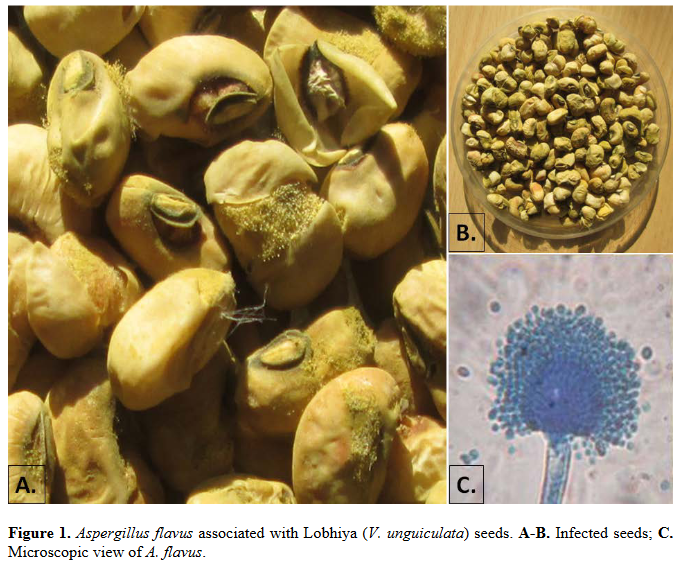Detection of Aflatoxin Producing Aspergillus flavus in Post-harvest Contaminated Vigna ungulculata Seeds
Keywords:
Vigna unguiculata (L.) Walp., post-harvest spoilage, Aspergillus flavus, aflatoxinsAbstract
The present study was carried out with a specific objective to study post-harvest spoilage of Lobhiya (Vigna unguiculata) seeds contaminated with Aspergillus flavus. Infected seeds were collected and cultured on potato dextrose
agar (PDA) media, at 25±2 °C. Aspergillus flavus isolates were primarily characterized by its morphological and microscopic characteristics. Collected fungal isolates were also screened for their afaltoxigenic nature on preliminary basis and at molecular level. For preliminary screening, 5 mm disc of fungal culture was soaked with few drops of liquid ammonia. Color change from yellow
pigment to plum-red with different intensities showed the mycotoxic nature of the fungus. DNA from fungal isolates was isolated and amplified using PCR with aflatoxin specific primers, apa-2, ver-1 and omt-1. Amplicons of 1032 bp, 895 bp
and 596 bp were obtained in most of the isolates regardless of primer set used which was useful to differentiate between mycotoxic and nontoxic isolates of A. flavus. The isolation of aflatoxigenic strains of A. flavus during post-harvest period
of lobhiya seeds raise a serious concern over the quality of seeds and a threat to heath of consumers. It was concluded that Aspergillus flavus is responsible for postharvest spolilage of Lobhiya (Vigna unguiculata).
References
Davis D. W., E. A. Oelke, E. S. Oplinger, J. D.Doll, C. V. Hanson & D. H. Putnam. 1991.Cowpea In alternative field crop manual. Uni-
versity of Wisconsin - Madison, West Indies.http://www.hort.purdue.edu/newcrop/afm/cowpea.html (Last accessed 01.07. 2014).
Embaby EM, R. Mohamed, A. A. Mosaad, O. Hassan & M. M. Asmaa. 2013. Occurrence of toxigenic fungi and mycotoxins in some
legume seeds. J Agri Tech 9(1):151-164.
Fawole O. B., O. Ahmed & O. S. Balogun. 2006.Pathogenicity and cell wall-degrading enzyme activities of some fungal isolates from cowpea(Vigna unguiculata [L] Walp). Biokemistri 18(1):45-51.
Houssou P. A., B. C. Ahohuendo, P.Fandohan, K. Kpodo, D. J. Hounhouigan & M. Jakobsen. 2009. Natural infection of cowpea (Vigna unguiculata (L.) Walp.) by toxigenic fungi and mycotoxin contamination in Benin, West Africa. J Stored Prod Res 45(1): 40-44.
Kritzinger Q, T. A. S. Aveling, W. F. O. Marasas, J. P. Rheeder, L. V. D. Westhuizen, G. S. Shephard. 2003. Mycoflora and Fumini-
sin mycotoxins associated with Cowpea[Vigna unguiculata (L.) Walp.] seeds. J Agri Food Chem 51: 2188-2192.
Saad S, Raghunathan AN, Shetty HS (1988) Seed mycoflora of Cowpea (Vigna unguiculata (L) Walp) and their pathogenic importance. Seed Sci Technol 16: 541-548.
Saito M. & S. Machida. 1999. A rapid identifica-tion method for aflatoxin producing strains of A. flavus and A. parasiticus by ammonia
vapor. Mycoscience 40: 205 -211.

Downloads
Published
How to Cite
Issue
Section
License
Copyright (c) 2022 Suan Sunandha Rajabhat University

This work is licensed under a Creative Commons Attribution 4.0 International License.











